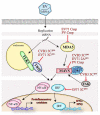Enter at your own risk: how enteroviruses navigate the dangerous world of pattern recognition receptor signaling - PubMed (original) (raw)
Review
Enter at your own risk: how enteroviruses navigate the dangerous world of pattern recognition receptor signaling
Katharine G Harris et al. Cytokine. 2013 Sep.
Abstract
Enteroviruses are the most common human viral pathogens worldwide. This genus of small, non-enveloped, single stranded RNA viruses includes coxsackievirus, rhinovirus, echovirus, and poliovirus species. Infection with these viruses can induce mild symptoms that resemble the common cold, but can also be associated with more severe syndromes such as poliomyelitis, neurological diseases including aseptic meningitis and encephalitis, myocarditis, and the onset of type I diabetes. In humans, polarized epithelial cells lining the respiratory and/or digestive tracts represent the initial sites of infection by enteroviruses. Control of infection in the host is initiated through the engagement of a variety of pattern recognition receptors (PRRs). PRRs act as the sentinels of the innate immune system and serve to alert the host to the presence of a viral invader. This review assembles the available data annotating the role of PRRs in the response to enteroviral infection as well as the myriad ways by which enteroviruses both interrupt and manipulate PRR signaling to enhance their own replication, thereby inducing human disease.
Keywords: Enterovirus; RIG-I-like receptor; Toll-like receptor; Type I IFN.
Copyright © 2013 Elsevier Ltd. All rights reserved.
Figures
Figure 1. Schematic of the EV genome
The positive sense single stranded RNA genome undergoes IRES dependent translation into a single polypeptide. This polypeptide is then processed into individual viral proteins by two viral proteases: 2Apro and 3Cpro (shown in red), as indicated by arrows. These viral proteases also act upon a wide range of host cell proteins.
Figure 2. Interference of PRR-mediated signaling by EVs
EVs have evolved multiple mechanisms to attenuate and/or modulate PRR signaling at a number of diverse stages. This results in a reduction of type I IFN production and/or NF-κB mediated transcription and allows the virus to evade detection by the innate immune system.
Similar articles
- Innate Immunity Evasion by Enteroviruses: Insights into Virus-Host Interaction.
Lei X, Xiao X, Wang J. Lei X, et al. Viruses. 2016 Jan 15;8(1):22. doi: 10.3390/v8010022. Viruses. 2016. PMID: 26784219 Free PMC article. Review. - The interaction between human enteroviruses and type I IFN signaling pathway.
Lu J, Yi L, Ke C, Zhang Y, Liu R, Chen J, Kung HF, He ML. Lu J, et al. Crit Rev Microbiol. 2015 Jun;41(2):201-7. doi: 10.3109/1040841X.2013.813903. Epub 2013 Aug 6. Crit Rev Microbiol. 2015. PMID: 23919297 Review. - Enteroviruses: A Gut-Wrenching Game of Entry, Detection, and Evasion.
Wells AI, Coyne CB. Wells AI, et al. Viruses. 2019 May 21;11(5):460. doi: 10.3390/v11050460. Viruses. 2019. PMID: 31117206 Free PMC article. Review. - Activation and pathogenic manipulation of the sensors of the innate immune system.
Odendall C, Kagan JC. Odendall C, et al. Microbes Infect. 2017 Apr-May;19(4-5):229-237. doi: 10.1016/j.micinf.2017.01.003. Epub 2017 Jan 14. Microbes Infect. 2017. PMID: 28093320 Free PMC article. Review. - Viral Inhibition of PRR-Mediated Innate Immune Response: Learning from KSHV Evasion Strategies.
Lee HR, Choi UY, Hwang SW, Kim S, Jung JU. Lee HR, et al. Mol Cells. 2016 Nov 30;39(11):777-782. doi: 10.14348/molcells.2016.0232. Epub 2016 Nov 18. Mol Cells. 2016. PMID: 27871174 Free PMC article. Review.
Cited by
- Recent progress in understanding coxsackievirus replication, dissemination, and pathogenesis.
Sin J, Mangale V, Thienphrapa W, Gottlieb RA, Feuer R. Sin J, et al. Virology. 2015 Oct;484:288-304. doi: 10.1016/j.virol.2015.06.006. Epub 2015 Jul 1. Virology. 2015. PMID: 26142496 Free PMC article. Review. - Type III interferon signaling restricts enterovirus 71 infection of goblet cells.
Good C, Wells AI, Coyne CB. Good C, et al. Sci Adv. 2019 Mar 6;5(3):eaau4255. doi: 10.1126/sciadv.aau4255. eCollection 2019 Mar. Sci Adv. 2019. PMID: 30854425 Free PMC article. - Direct Identification of Enteroviruses in Cerebrospinal Fluid of Patients with Suspected Meningitis by Nested PCR Amplification.
Krasota A, Loginovskih N, Ivanova O, Lipskaya G. Krasota A, et al. Viruses. 2016 Jan 6;8(1):10. doi: 10.3390/v8010010. Viruses. 2016. PMID: 26751470 Free PMC article. - Enterovirus D68 and Human Respiratory Infections.
Xiang Z, Wang J. Xiang Z, et al. Semin Respir Crit Care Med. 2016 Aug;37(4):578-85. doi: 10.1055/s-0036-1584795. Epub 2016 Aug 3. Semin Respir Crit Care Med. 2016. PMID: 27486738 Free PMC article. Review. - Innate Immune Evasion by Human Respiratory RNA Viruses.
Kikkert M. Kikkert M. J Innate Immun. 2020;12(1):4-20. doi: 10.1159/000503030. Epub 2019 Oct 14. J Innate Immun. 2020. PMID: 31610541 Free PMC article. Review.
References
- Centers for Disease Control Non-Polio Enterovirus Infections. 2011
- International Committee on Taxonomy of Viruses Virus Taxonomy: 2012 Release (current) 2012
- Khetsuriani N, Lamonte-Fowlkes A, Oberst S, Pallansch MA. Enterovirus surveillance--United States, 1970-2005. MMWR Surveill Summ. 2006;55:1–20. - PubMed
- Huang C, Morse D, Slater B, Anand M, Tobin E, Smith P, et al. Multiple-year experience in the diagnosis of viral central nervous system infections with a panel of polymerase chain reaction assays for detection of 11 viruses. Clin Infect Dis. 2004;39:630–5. - PubMed
- Koskiniemi M, Rantalaiho T, Piiparinen H, von Bonsdorff CH, Farkkila M, Jarvinen A, et al. Infections of the central nervous system of suspected viral origin: a collaborative study from Finland. J Neurovirol. 2001;7:400–8. - PubMed
Publication types
MeSH terms
Substances
Grants and funding
- R01-AI081759/AI/NIAID NIH HHS/United States
- T32-AI-049820/AI/NIAID NIH HHS/United States
- T32 AI049820/AI/NIAID NIH HHS/United States
- T32 AI060525/AI/NIAID NIH HHS/United States
- R01 AI081759/AI/NIAID NIH HHS/United States
LinkOut - more resources
Full Text Sources
Other Literature Sources

